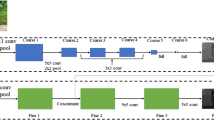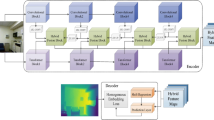Abstract
Predicting the depth of a scene from monocular infrared images, which plays a crucial role in understanding three-dimensional structures, is one of the challenging tasks in machine learning and computer vision. Considering the lack of texture and color information in infrared images, a novel discrete convolutional conditional random field network is proposed for depth estimation. The proposed method inherits several merits of conditional random fields and deep learning. First, the pairwise features are automatically extracted and optimized through deep architectures. Second, the monocular-images-based depth regression is converted into a multi-class classification, in which the order information of different levels of depths is considered in the loss function. Our experiments demonstrate that this conversion achieves much higher accuracy and faster conversion. Third, to obtain fine-grained level details, we have further proposed a multi-scale discrete convolutional conditional random field network that computes the pairwise features of the discrete conditional random field at different spatial levels. Extensive experiments on the infrared image dataset NUSTMS demonstrate that the proposed method outperforms other depth estimation methods. Specifically, for the proposed method, the mean relative error is 0.181, the mean log10 error is 0.072, and the accuracy with a threshold (t = 1.253) is 95.3%.













Similar content being viewed by others
References
Eigen D, Puhrsch C, Fergus R et al (2014) Depth map prediction from a single image using a multi-scale deep network. Adv Neural Inf Process Syst 2014:2366–2374
Eigen D, Fergus R (2015) Predicting depth, surface normals and semantic labels with a common multi-scale convolutional architecture. Int Conf Comput Vision 2015:2650–2658
Martínez Torres J, Iglesias Comesaña C, García-Nieto PJ (2019) Review: machine learning techniques applied to cybersecurity. Int J Mach Learn Cybernet 10(10):2823–2836
Saxena A, Chung SH, Ng AY (2005) Learning depth from single monocular images. Adv Neural Inf Process Syst 2005:1161–1168
Saxena A, Sun M, Ng AY (2009) Makethree-dimensional: learning three-dimensional scene structure from a single still image. IEEE Trans Pattern Anal Mach Intell 31(5):824–840
Liu B, Gould S, Koller D (2010) Single image depth estimation from predicted semantic labels. Proc IEEE Conf Comput Vision Pattern Recognit 2010:1253–1260
Liu M, Salzmann M, He X (2014) Discrete-continuous depth estimation from a single image. Proc IEEE Conf Comput Vision Pattern Recognit 2014:716–723
Zheng S, Jayasumana S, Romera-Paredes B et al (2016) Conditional random fields as recurrent neural networks. IEEE Int Conf Comput Vision 2016:1529–1537
Zhao H, Shi J, Qi X et al (2017) Pyramid scene parsing network. Proc IEEE Conf Comput Vision Pattern Recognit 2017:2881–2890
Farabet C, Couprie C, Najman L et al (2013) Learning hierarchical features for scene labeling. IEEE Trans Pattern Anal Mach Intell 35(8):1915–1929
Li NB, Shen NC, Dai NY et al (2015) Depth and surface normal estimation from monocular images using regression on deep features and hierarchical CRFs. Proc IEEE Conf Comput Vision Pattern Recognit 2015:1119–1127
Liu F, Shen C, Lin G (2015) Deep convolutional neural fields for depth estimation from a single image. Proc IEEE Conf Comput Vision Pattern Recognit 2015:5162–5170
Liu F, Shen C, Lin G et al (2015) Learning depth from single monocular images using deep convolutional neural fields. IEEE Trans Pattern Anal Mach Intell 38(10):2024–2039
Cao Y, Wu Z, Shen C (2018) Estimating depth from monocular images as classification using deep fully convolutional residual networks. IEEE Trans Circuits Syst Video Technol 2018:3174–3182
Ibarra-Castanedo C et al (2004) Infrared image processing and data analysis. Infrared Phys Technol 46(1):75–83
Krähenbühl P, Koltun V (2011) Efficient inference in fully connected CRFs with Gaussian edge potentials. Adv Neural Inf Process Syst 24:109–117
Noh H, Hong S, Han B (2015) Learning deconvolution network for semantic segmentation. IEEE Int Conf Comput Vision 2015:1520–1528
Xu D, Ricci E, Ouyang W et al (2017) Multi-scale continuous CRFs as sequential deep networks for monocular depth estimation. Proc IEEE Conf Comput Vision Pattern Recognit 2017:161–169
Wu S, Zhao H, Sun S (2019) Depth estimation from infrared video using local-feature-flow neural network. Int J Mach Learn Cybernet 10(9):2563–2572
Xu D, Ouyang W, Wang X, Sebe N (2018) Pad-net: Multitasks guided prediciton-and-distillation network for simultaneous depth estimation and scene parsing. arXiv preprint arXiv:1805.04409
Simonyan K, Zisserman A (2015) Very deep convolutional networks for large-scale image recognition. arXiv preprint arXiv:1409.1556
Szegedy C, Liu W, Jia Y et al (2015) Going deeper with convolutions. Proc IEEE Conf Comput Vision Pattern Recognit 2015:1–9
He K, Zhang X, Ren S, Sun J (2016) Deep residual learning for image recognition. Proc IEEE Conf Comput Vision Pattern Recognit 2016:770–778
Szegedy C, Ioffe S, Vanhoucke V et al (2017) Inception-v4, inception-ResNet and the impact of residual connections on learning. 31st AAAI conference on artificial intelligence 2017:4278–4284
Gu TT, Zhao HT, Sun SY (2018) Depth estimation of infrared image based on pyramid residual neural networks. Infrared Technol 40(5)
Godard C, Mac Aodha O, Brostow GJ (2017) Unsupervised monocular depth estimation with left-right consistency. Proc IEEE Conf Comput Vision Pattern Recognit 2017:6602–6611
Kundu JN, Uppala PK, Pahuja A et al (2018) AdaDepth: unsupervised content congruent adaptation for depth estimation. Proc IEEE Conf Comput Vision Pattern Recognit 2018:2656–2665
Pilzer A, Xu D, Puscas MM et al (2018) Unsupervised adversarial depth estimation using cycled generative networks. Int Conf Three-dimens Vision 2018:587–595
Kuznietsov Y, Stückler J, Leibe B (2017) Semi-supervised deep learning for monocular depth map prediction. Proc IEEE Conf Comput Vision Pattern Recognit 2017:2215–2223
Fu H, Gong M, Wang C et al (2018) Deep ordinal regression network for monocular depth estimation. Proc IEEE Conf Comput Vision Pattern Recognit 2018:2002–2011
Srivastava N, Hinton G, Krizhevsky A et al (2014) Dropout: a simple way to prevent neural networks from overfitting. J Mach Learn Res 15:1929–1958
Viswanathan R (1993) A note on distributed estimation and sufficiency. IEEE Trans Inf Theory 39(5):1765–1767
Author information
Authors and Affiliations
Corresponding author
Additional information
Publisher's Note
Springer Nature remains neutral with regard to jurisdictional claims in published maps and institutional affiliations.
Rights and permissions
About this article
Cite this article
Wang, Q., Zhao, H., Hu, Z. et al. Discrete convolutional CRF networks for depth estimation from monocular infrared images. Int. J. Mach. Learn. & Cyber. 12, 187–200 (2021). https://doi.org/10.1007/s13042-020-01164-w
Received:
Accepted:
Published:
Issue Date:
DOI: https://doi.org/10.1007/s13042-020-01164-w




